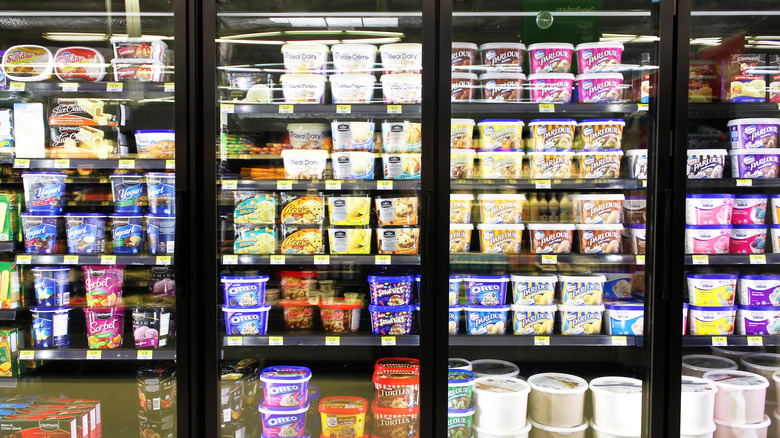The Ice Cream Upgrade You Need For Thick, Creamy Milkshakes
Imagine this: It's summer, the sun is shining, and you're cooling off with a thick, frozen, creamy milkshake. Is there anything more satisfying? To make a milkshake you'll think about for weeks and want to whip up on repeat, you don't need to learn from grizzled soda jerks or own any bougie milk shake-making equipment. This incredibly cool and exceedingly simple upgrade is all about the frozen stuff.
Despite what the treat's name might imply, the star of any milkshake is the ice cream. So, for the creamiest, dreamiest milkshake you've ever had, you should pay attention to both the quality and quantity of scoops you're using. The secret to the most decadent shake is using a better quality ice cream, and far more of it than you might think, versus just using up whatever errant pint or tub you happen to have left in the bottom of the freezer. Plan to load up your blender or milkshake maker with well beyond a single scoop. Even two scoops can become watered down and lost in all the milk, resulting in a runny, bland milkshake that wouldn't bring anyone to the yard.
Get choosy about the quality of ice cream and milk
To get serious about your milkshake quality, you need to be mindful of your components. This is the time to be a snob about choosing the best brand of ice cream with the best ingredients. In your local grocery store ice cream aisle, you're presented with a wide range of brands, flavors, and dairy bases. Many of the more affordable or big brand name ice creams can be chock full of high fructose corn syrup, additional sweeteners, artificial flavors, and even lots of added air, in the case of the lower calorie or cheaper pint options. None of these are optimal when making milkshakes, as the super high sugar content can be unpleasant, and lighter ice creams won't yield the fatty richness you need.
Additions like cookie dough, Oreo chunks, and the like will get pulverized into a somewhat gritty texture, so it's best to stick to plain flavors or those with soft mix-ins like caramel for the most velvety smooth mix. A higher fat content is paramount to achieving the best flavor and consistency, both for the ice cream and the milk you choose. Look for pints made with whole milk (or coconut or oat milk if you're dairy-free). Similarly, use full-fat milk or even heavy cream, or, if you eat a plant-based diet, opt for oat or coconut milk over waterier almond milk. Blending your shakes with these richer milks will give you the thickest frozen treats possible.
Use many more scoops than you think you need
For the densest, creamiest milkshake, you should be chasing a consistency far closer to ice cream than milk. Think of the extremely thick concoctions from certain fast food chains — these types of shakes are verging on solid rather than liquid. Depending on personal preference, you might still want an easily slurpable shake, but it should ideally have some resistance and a texture that can be enjoyed with either a straw or a spoon.
To achieve this level of viscosity, load up your blender cup with at least four hefty scoops of ice cream — close to a pint's worth. For a restaurant-quality shake, you can't skimp on the scoops. Even if you choose a high-quality ice cream with less sugar, you'll still want to steer clear of excessively sugary add-ins like artificially flavored fudge to maintain your shake's integrity. Try other creative additions instead — like fresh fruit, smooth organic peanut butter, or a spoonful of malted milk powder for a whole different flavor from a standard shake. Or, pour in a bit of the hard stuff for an adults-only boozy milkshake.


